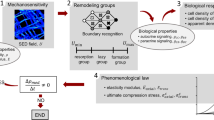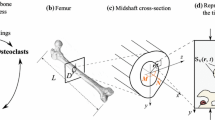Abstract
A bone cell population dynamics model for cortical bone remodeling under mechanical stimulus is developed in this paper. The external experiments extracted from the literature which have not been used in the creation of the model are used to test the validity of the model. Not only can the model compare reasonably well with these experimental results such as the increase percentage of final values of bone mineral content (BMC) and bone fracture energy (BFE) among different loading schemes (which proves the validity of the model), but also predict the realtime development pattern of BMC and BFE, as well as the dynamics of osteoblasts (OBA), osteoclasts (OCA), nitric oxide (NO) and prostaglandin E2 (PGE2) for each loading scheme, which can hardly be monitored through experiment. In conclusion, the model is the first of its kind that is able to provide an insight into the quantitative mechanism of bone remodeling at cellular level by which bone cells are activated by mechanical stimulus in order to start resorption/formation of bone mass. More importantly, this model has laid a solid foundation based on which future work such as systemic control theory analysis of bone remodeling under mechanical stimulus can be investigated. The to-be identified control mechanism will help to develop effective drugs and combined nonpharmacological therapies to combat bone loss pathologies. Also this deeper understanding of how mechanical forces quantitatively interact with skeletal tissue is essential for the generation of bone tissue for tissue replacement purposes in tissue engineering.
Similar content being viewed by others
References
Frost, H.M.: Intermediary Organization of the Skeleton. CRC Press, Boca Raton, Fla (1986)
Robling, A.G., Castillo, A.B., Turner, C.H.: Biomechanical and molecular regulation of bone remodeling. Annu. Rev. Biomed. Eng. 8, 455–498 (2006)
Schneider, V., Oganov, V., LeBlanc, A., et al.: Bone and body mass changes during space flight. Acta Astronaut. 36, 463–466 (1995)
Qin, Q.H., Ye, J.Q.: Thermoelectroelastic solutions for internal bone remodeling under axial and transverse loads. Int. J. Solids Struct. 41, 2447–2460 (2004)
Qin, Q.H., Qu, C.Y., Ye, J.Q.: Thermo electroelastic solutions for surface bone remodeling under axial and transverse loads. Biomaterials 26, 6798–6810 (2005)
Ducher, G., Jaffre, C., Arlettaz, A., et al.: Effects of long-term tennis playing on the muscle-bone relationship in the dominant and nondominant forearms. Canadian Journal of Applied Physiology 30, 3–17 (2005)
Bass, S.L., Saxon, L., Daly, R.M., et al.: The effect of mechanical loading on the size and shape of bone in pre-, peri-, and postpubertal girls: A study in tennis players. J. Bone Miner. Res. 17, 2274–2280 (2002)
Robling, A.G., Hinant, F.M., Burr, D.B., et al.: Improved bone structure and strength after long-term mechanical loading is greatest if loading is separated into short bouts. J. Bone Miner. Res. 17, 1545–1554 (2002)
MacKay, C., Lorincz, C., Zernicke, R.: Mechanisms of bone remodeling during weight-bearing exercise. Applied Physiology, Nutrition, and Metabolism 31, 655–660 (2006)
Kroll, M.: Parathyroid hormone temporal effects on bone formation and resorption. Bulletin of Mathematical Biology 62, 163–188 (2000)
Rattanakul, C., Lenbury, Y., Krishnamara, N., et al.: Modeling of bone formation and resorption mediated by parathyroid hormone: Response to estrogen/PTH therapy. Biosystems 70, 55–72 (2003)
Komarova, S.V., Smith, R.J., Dixon, S.J., et al.: Mathematical model predicts a critical role for osteoclast autocrine regulation in the control of bone remodeling. Bone 33, 206–215 (2003)
Komarova, S.V.: Mathematical model of paracrine interactions between osteoclasts and osteoblasts predicts anabolic action of parathyroid hormone on bone. Endocrinology 146, 3589–3595 (2005)
Potter, L.K., Greller, L.D., Cho, C.R., et al.: Response to continuous and pulsatile PTH dosing: A mathematical model for parathyroid hormone receptor kinetics. Bone 37, 159–169 (2005)
Lemaire, V., Tobin, F.L., Greller, L.D., et al.: Modeling the interactions between osteoblast and osteoclast activities in bone remodeling. Journal of Theoretical Biology 229, 293–309 (2004)
Wang, Y.N., Qin, Q.H., Kalyanasundaram, S.: A theoretical model for simulating effect of Parathyroid Hormone on bone metabolism at cellular level. Molecular & Cellular Biomechanics 6, 101–112 (2009)
Pivonka, P., Zimak, J., Smith, D.W., et al.: Model structure and control of bone remodeling: A theoretical study. Bone 43, 249–263 (2008)
Mullender, M.G., Huiskes, R., Weinans, H.: A physiological approach to the simulation of bone remodeling as a self organization control process. Journal of Biomechanics 27, 1389–1394 (1994)
Ruimerman, R., Hilbers, P., van Rietbergen, B., et al.: A theoretical framework for strain-related trabecular bone maintenance and adaptation. J. Biomech. 38, 931–941 (2005)
Ruimerman, R., Huiskes, R., van Lenthe, G.H., et al.: A computer-simulation model relating bone-cell metabolism to mechanical adaptation of trabecular architecture. Computer Methods in Biomechanics and Biomedical Engineering 4, 433–448 (2001)
Weinans, H., Huiskes, R., Grootenboer, H.J.: The behavior of adaptive bone-remodeling simulation models. Journal of Biomechanics 25, 1425–1441 (1992)
Li, J., Li, H., Shi, L., et al.: A mathematical model for simulating the bone remodeling process under mechanical stimulus. Dental Materials 23, 1073–1078 (2007)
Hadjidakis, D.J., Androulakis, I.I.: Bone remodeling. Annals of the New York Academy of Sciences 1092, 385–396 (2006)
Maldonado, S., Findeisen, R., Allgower, F.: Describing forceinduced bone growth and adaptation by a mathematical model. Journal of Musculoskeletal and Neuronal Interactions 8, 15–17 (2008)
Maldonado, S., Borchers, S., Findeisen, R., et al.: Mathematical modeling and analysis of force induced bone growth. Conf. Proc. IEEE Eng. Med. Biol. Soc. 1, 3154–3157 (2006)
Tanaka, E., Yamamoto, S., Aoki, Y., et al.: Formulation of a mathematical model for mechanical bone remodeling process. JSME International Journal Series C-Mechanical Systems Machine Elements and Manufacturing 43, 830–836 (2000)
Frost, H.M.: Bone Remodelling Dynamics, Vol. 59. Spring-field, Illinois, USA (1963)
Anderson, D.M., Maraskovsky, E., Billingsley, W.L., et al.: A homologue of the TNF receptor and its ligand enhance Tcell growth and dendritic-cell function. Nature 390, 175–179 (1997)
Khosla, S.: Minireview: The OPG/RANKL/RANK System. Endocrinology 142, 5050–5055 (2001)
Zaidi, M.: Skeletal remodeling in health and disease. Nature Medicine 13, 791–801 (2007)
Hofbauer, L.C., Khosla, S., Dunstan, C.R., et al.: The roles of osteoprotegerin and osteoprotegerin ligand in the paracrine regulation of bone resorption. J. Bone Miner. Res. 15, 2–12 (2000)
Parfitt, A.M., Chir, B.: Cellular basis of bone turnover and bone loss — rebuttal of osteocytic resorption-bone flow theory. Clinical Orthopaedics and Related Research 127, 236–247 (1977)
Doty, S.: Morphological evidence of gap junctions between bone cells. Calcified Tissue International 33, 509–512 (1981)
Shapiro, F.: Variable conformation of gap junctions linking bone cells: A transmission electron microscopic study of linear, stacked linear, curvilinear, oval, and annular junctions. Calcified Tissue International 61, 285–293 (1997)
Nijweide, P.J., Burger, E.H., Klein-Nulend, J.: The osteocyte. In: Bilezikian, J.P., Raisz, L.G., Rodan, G.A., eds. Principles of Bone Biology, Academic Press, San Diego, USA (2002)
Knothe Tate, M.L., Steck, R., Forwood, M.R., et al.: In vivo demonstration of load-induced fluid flow in the rat tibia and its potential implications for processes associated with functional adaptation. The Journal of Experimental Biology 203, 2737–2745 (2000)
Weinbaum, S., Cowin, S.C., Zeng, Y.: A model for the excitation of osteocytes by mechanical loading-induced bone fluid shear stresses. Journal of Biomechanics 27, 339–360 (1994)
Klein-Nulend, J., Bacabac, R.G., Mullender, M.G.: Mechanobiology of bone tissue. Pathologie-biologie 53, 576–580 (2005)
Ajubi, N.E., KleinNulend, J., Nijweide, P.J., et al.: Pulsating fluid flow increases prostaglandin production by cultured chicken osteocytes—A cytoskeleton-dependent process. Biochemical and Biophysical Research Communications 225, 62–68 (1996)
Mullender, M., El Haj, A., Yang, Y., et al.: Mechanotransduction of bone cellsin vitro: Mechanobiology of bone tissue. Medical and Biological Engineering and Computing 42, 14–21 (2004)
Bacabac, R.G., Smit, T.H., Mullender, M.G., et al.: Nitric oxide production by bone cells is fluid shear stress rate dependent. Biochemical and biophysical research communications 315, 823–829 (2004)
Burger, E.H., Klein-Nulend, J.: Mechanotransduction in bone—role of the lacuno-canalicular network. FASEB J. 13, 101–112 (1999)
Fan, X., Roy, E., Zhu, L., et al.: Nitric oxide regulates receptor activator of nuclear factor-κ B ligand and osteoprotegerin expression in bone marrow stromal cells. Endocrinology 145, 751–759 (2004)
Machwate, M., Harada, S., Leu, C.T., et al.: Prostaglandin receptor EP4 mediates the bone anabolic effects of PGE2. Molecular Pharmacology 60, 36–41 (2001)
Hill, A.V.: The possible effects of the aggregation of the molecules of hemoglobin on its dissociation curves. J. Physiol. (Lond.) 40, 389–403 (1910)
Alon, U.: An Introduction to Systems Biology: Design Principles of Biological Circuits. CRC Press, New York, USA (2007)
Roodman, G.D.: Cell biology of the osteoclast. Experimental Hematology 27, 1229–1241 (1999)
Bonewald, L.F., Dallas, S.L.: Role of active and latent transforming growth-factor-beta in bone-formation. Journal of Cellular Biochemistry 55, 350–357 (1994)
Alliston, T., Choy, L., Ducy, P., et al.: TGF-beta-induced repression of CBFA1 by Smad3 decreases cbfa1 and osteocalcin expression and inhibits osteoblast differentiation. Embo Journal 20, 2254–2272 (2001)
Saxon, L.K., Robling, A.G., Alam, I., et al.: Mechanosensitivity of the rat skeleton decreases after a long period of loading, but is improved with time off. Bone 36, 454–464 (2005)
Bergmann, G., Graichen, F., Rohlmann, A.: Hip joint force measurements. http://www.medizin.fu-berlin.de/missing.html (2003)
Turner, C.H., Forwood, M.R., Otter, M.W.: Mechanotransduction in bone: do bone cells act as sensors of fluid flow? FASEB J. 8, 875–878 (1994)
Warden, S.J., Turner, C.H.: Mechanotransduction in the cortical bone is most efficient at loading frequencies of 5–10 Hz. Bone 34, 261–270 (2004)
Rubin, C., Xu, G., Judex, S.: The anabolic activity of bone tissue, suppressed by disuse, is normalized by brief exposure to extremely low-magnitude mechanical stimuli. FASEB J. 15, 2225–2229 (2001)
Burr, D.B., Robling, A.G., Turner, C.H.: Effects of biomechanical stress on bones in animals. Bone 30, 781–786 (2002)
Robling, A.G., Burr, D.B., Turner, C.H.: Recovery periods restore mechanosensitivity to dynamically loaded bone. J. Exp. Biol. 204, 3389–3399 (2001)
Schriefer, J.L., Warden, S.J., Saxon, L.K., et al.: Cellular accommodation and the response of bone to mechanical loading. Journal of Biomechanics 38, 1838–1845 (2005)
Klein-Nulend, J., van der Plas, A., Semeins, C.M., et al.: Sensitivity of osteocytes to biomechanical stress in vitro. FASEB J. 9, 441–445 (1995)
Bakker, A.D., Soejima, K., Klein-Nulend, J., et al.: The production of nitric oxide and prostaglandin E2 by primary bone cells is shear stress dependent. Journal of Biomechanics 34, 671–677 (2001)
Riggs, C.M., Lanyon, L.E., Boyde, A.: Functional associations between collagen fibre orientation and locomotor strain direction in cortical bone of the equine radius. Anatomy and Embryology 187, 231–238 (1993)
Ascenzi, A., Bonucci, E.: Tensile properties of single osteons. Anatomical Record 158, 375–386 (1967)
Ascenzi, A., Bonucci, E.: The compressive properties of single osteons. Anatomical Record 161, 377–391 (1968)
Burr, D.B., Hirano, T., Turner, C.H., et al.: Intermittently administered human parathyroid hormone (1–34) treatment increases intracortical bone turnover and porosity without reducing bone strength in the humerus of ovariectomized cynomolgus monkeys. J. Bone Miner. Res. 16, 157–165 (2001)
Noble, B.S., Peet, N., Stevens, H.Y., et al.: Mechanical loading: Biphasic osteocyte survival and targeting of osteoclasts for bone destruction in rat cortical bone. American Journal of Physiology-Cell Physiology 284, C934–C943 (2003)
Author information
Authors and Affiliations
Corresponding author
Rights and permissions
About this article
Cite this article
Qin, QH., Wang, YN. A mathematical model of cortical bone remodeling at cellular level under mechanical stimulus. Acta Mech Sin 28, 1678–1692 (2012). https://doi.org/10.1007/s10409-012-0154-z
Received:
Revised:
Accepted:
Published:
Issue Date:
DOI: https://doi.org/10.1007/s10409-012-0154-z




